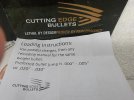I guess my coffee hasn't kicked in this morning. 
I have some CE Lazer bullets I plan to try in several rifles. The instructions below is what was in the box:

Am I reading that preferred seating depth is .000 to .005 off the lands and if that doesn't work try .020 - .030? The "of" on there is confusing. I'm guessing that maybe should said "or"?
I have some CE Lazer bullets I plan to try in several rifles. The instructions below is what was in the box:
Am I reading that preferred seating depth is .000 to .005 off the lands and if that doesn't work try .020 - .030? The "of" on there is confusing. I'm guessing that maybe should said "or"?


